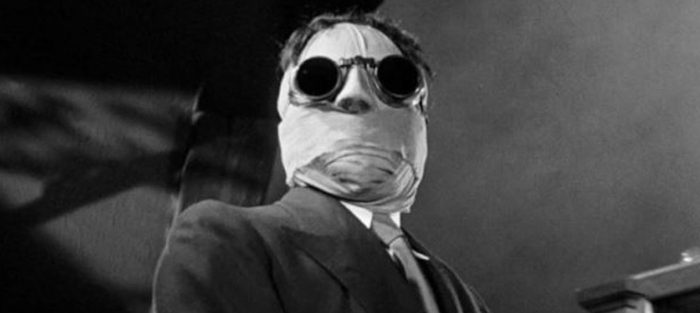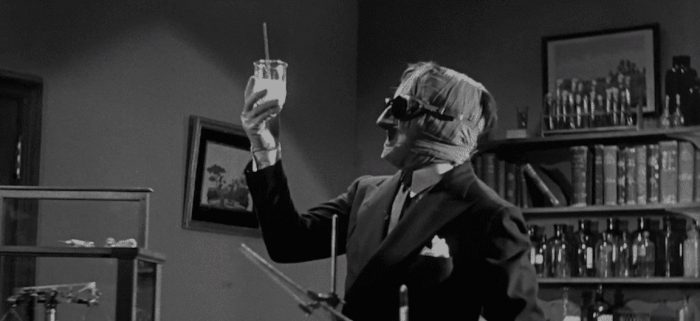
We live in an era of franchises, filled with an abundance of sequels and every studio wanting their own shared cinematic universe. But while the big franchises of today are mostly comic-book, Star Wars and action movies like Fast and Furious – with a couple of horror ones here and there like the highly successful Conjuring universe – back in the 1930s the biggest cinematic universe belonged to the misunderstood monsters of the Universal Classic Monsters movies. But while Boris Karloff’s portrayal of Frankenstein’s Monster, or Bela Lugosi’s Dracula have remained iconic representations of this classic horror era, there is one truly horrific monster that usually can’t be found in the picture – Claude Rains’ The Invisible Man.
After the success of 1923’s The Hunchback of Notre Dame, Universal Studios began its reign as the leading producer of horror cinema, introducing a series of film monsters adapted from classic gothic novels and folkloric traditions that paved the way not only for the rise in popularity of the horror genre, but for the rise of shared universes. Following the release of Frankenstein, English film and theater director James Whale set up to adapt H.G. Wells’ 1897 sci-fi novel The Invisible Man. The film recounts the tale of Dr. Jack Griffin (Claude Rains), a renegade young chemist who experiments with a plant-derived compound known as monocaine and renders himself invisible.
The Invisible Man sneaks up on its audience with a much more somber tale than it initially teases. You would be forgiven for thinking that a guy who just so happens to be invisible isn’t as menacing as a Lovecraftian fish-guy, a tragic lycanthrope or an undead abomination. The film follows the tradition of the other Universal Classic Monsters by turning its titular monster into a complex and tragic protagonist. Not unlike Quasimodo or the Phantom of the Opera, Universal’s horror creations can all be considered reluctant monsters, cursed by external forces that made their sympathetic humanity hide underneath the scary looks. Even Dracula, though decidedly more sinister and way bloodier, still does what he does mostly to survive rather than being purely evil. When it comes to Jack Griffin, we do learn that monocaine exposure is known to cause insanity, and throughout the film we see Jack Griffin’s uncontrolled ambition turn into an inhuman disregard for others, with the doctor detaching himself from the human condition to the point that murder becomes a joke to him – like Victor Frankenstein, it is ambition that becomes the monster.
The one problem with this, which is what starts making The Invisible Man different than the other classic monster movies, is that we meet Griffin when he’s already taken the monocaine, so the influence of the compound on his personality remains a mystery to the audience. Maybe he was truly a victim of circumstance, but he also could have been a psychopathic monster all along.
Indeed, Jack Griffin is not exactly a tragic figure, as by the time we meet him, he’s already a bit of a megalomaniac with a wicked sense of humor. Though many critics and fans consider Abbott and Costello Meet Frankenstein to be the first big horror-comedy, it could be argued that James Whale’s The Invisible Man is as much an oddball comedy as it is a horror movie. The director effortlessly balances the horror with moments of levity, most of which comes from Una O’Connor’s Jenny Hall, the innkeeper’s wife with a knack for hysterics, who manages to steal every scene she’s in by proving she could have starred in a Howard Hawks screwball comedy. Then there’s Claude Rains himself, who starts out as a wise-cracking, entertaining psychopath who takes great pleasure in the small things, like toying with his victims while maniacally giggling before killing them, instigating chaos and destruction all with a deliciously evil cackle. It isn’t hard to see Rain’s Dr. Griffin as the cinematic precursor to other charismatic killers like Freddy Krueger, or even the Clown Prince of Crime himself, the Joker – Mark Hamill himself has named Claude as an inspiration for his portrayal of Joker.

The longer he remains invisible, the more Jack Griffin loses his grip on his sanity and humanity, committing increasingly bigger and more lethal acts of violence, like pushing over a baby carriage. Where the other Universal Classic Monsters are mostly just preoccupied with surviving in a world that hates them, their acts of violence and terror being mostly accidental, Jack Griffin is not only thriving as a monster, but has more ambitious plans. “An invisible man can rule the world,” Griffin excitedly exclaims in the movie. “Nobody will see him come, nobody will see him go. He can hear every secret. He can rob, and rape, and kill!”
With that, Jack Griffin becomes the only classic monster to be worthy of that title because of his actions instead of his looks. Where Frankenstein’s Monster, the Phantom or the Creature instantly cause fear in the hearts of those who come across it because of their appearance, Griffin reveals his inner monster through sadistic acts of violence that reflect his delusions of grandeur. We see him causing chaos and destruction simply because he knows he can get away with it. In one of the best villain monologues, Griffin tells us how he plans to start “a reign of terror,” with “a few murders here and there.” He adds, “Murders of great men, murders of little men… just to show we make no distinction. We might even wreck a train or two.” Indeed, The Invisible Man has arguably the largest body count in all the Universal Monster movies, mostly because of a terrifying scene where Jack derails a speeding train full of hundreds of innocent travelers.
Jack Griffin is truly an unforgivable villain, but it is due to Claude Rains’ performance and James Whale’s mixing of horror with comedy that the audience becomes fascinated with Griffin as a character. In fact, seeing some scenes or elements that might have been scary in 1933 are now comical doesn’t disturb the tone of the film, but doubles down on it.
In the years after the Universal Classic Monsters, characters like Dracula, the Mummy, and Frankenstein’s Monster became iconic partly due to Hammer horror movies of the ‘60s and ‘70s. Even if movie monsters started giving way to psychopathic killers and more human monsters that took pleasure in their sadistic work, the monster that arguably paved the way for characters like Freddy Krueger or Joker was mostly left behind in the shadows of his peers. Before Leigh Whannell scares the bejeezus out of you with The Invisible Man this weekend ,you should revisit the classic movie that showed us man is the scariest monster there is.
The post ‘The Invisible Man’ Remains The Scariest Of Universal’s Classic Movie Monsters appeared first on /Film.
from /Film https://ift.tt/3cheuWG
via IFTTT
Comments
Post a Comment